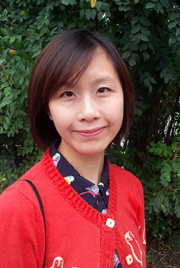To mow, or not to mow, that is the question
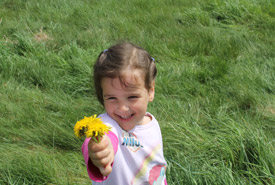
Maria Olkinitskaya picking dandelions at Baie Verte CV event, NB (Photo by NCC)
During the month of May, the Nature Conservancy of Canada (NCC) is encouraging people to hold off on trimming their lawn in favour of letting the flowers and grasses grow, to provide habitat for insects and birds. The idea is to reimagine our lawns and the spaces where we live and spend most of our time to make them more inviting for nature.
It’s easier said than done, though. In the spirit of No Mow May, common weeds like dandelions and violets can quickly turn your lawn into a field of yellows, whites and purples. The urge to mow and hand pull is real. So how do we strike a balance between supporting local wildlife while maintaining a manageable level of plant growth? I spoke to Dan Kraus, NCC’s senior conservation biologist, to understand the intricacies of gardening for biodiversity.
Wendy Ho (WH): Where did this No Mow May idea originate?
Dan Kraus (DK): No Mow May originated in the UK, but has spread to other countries. While the intent is to postpone the first spring mow as long as possible, the spirit of No Mow May is to get us to reimagine our lawns and other green spaces around us as an ecosystem. We can manage that ecosystem in a way that improves the health and diversity of nature.
Lawns certainly have a function, but there is a growing recognition that the space that we currently fill with a monoculture of high-maintenance grass could be something that is much more diverse and provides more benefits to nature and people.
WH: What are some practical considerations for people who want to suppress weeds but participate in this movement?
DK: When you eventually mow, this supresses weeds such as dandelions. The grass on your lawn, just like the grass in a prairie, is adapted to grazing. By mowing, you are simulating a grazing system that favours grass over other plants.
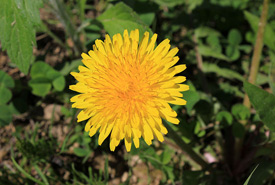
Dandelion (Photo by Yinan Chen, Wikimedia Commons)
The second part is to think about why you want to supress weeds. We often see beauty in a flower display in an alpine meadow or hardwood forest, but not in the diversity of plant species that our lawns can support.
You can participate to whatever level you are comfortable with. For some people this might be mowing just a little less, or leaving longer grass in a small area.
WH: Why the month of May? Can people do this all season, or adopt a less frequent mowing schedule?
DK: Absolutely. There was recently a great study that found you can increase plant and insect diversity by reducing how much you mow and letting your grass grow a little longer. This can also help reduce costs.
WH: How does wildlife benefit from a month-long pause in disruption to their micro landscape?
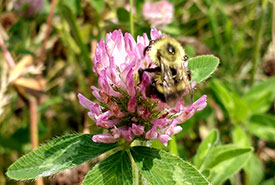
Bumble bee foraging on red clover (Photo by Amanda Liczner)
DK: Flowering plants in your lawn can provide a food source for pollinators and other insects. These, in turn, can provide a food source for both migrating and resident birds in the spring.
WH: What is the difference between just letting your lawn go wild versus a naturalized garden?
DK: These are two different things. Reducing mowing or letting your grass grow a little longer is not a naturalized garden. It’s still a lawn; just a slightly better lawn from the perspective of the plants, insects and birds that share that space.
A naturalized garden also has different meanings. It could be a garden that is simply not in orderly rows like you'd see in a Victorian garden. But more people today see a naturalized garden as a garden that uses native plants that are adapted to your local area. Not only are these plants better for local pollinators and other insects, and they often require less work. Perhaps even more importantly, it’s an opportunity to learn more about your local ecology.
WH: What advice do you have for people who want to establish a native garden, but miss having ornamental plants, or, for people like me, who have a yard overrun by weeds?
DK: Start small and accept uncertainty. Bringing native plants into your yard doesn’t mean you need to drastically change your gardens. Start with a couple of showy plants and build from there. You may miss your ornamental plants because you know what they are. Once you learn the names and stories of native plants, you will find connections to these species as well.
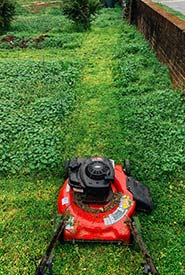
For some people, participating in No Mow May and beyond might be mowing just a little less, or leaving a small area in linger grass. (Photo by Kelly Lacy, Pexels)
If your garden is overrun by weeds, first learn the names of the plants. Second, I’d encourage you to get rid of species that are highly invasive, such as garlic mustard. Then, add a few native plants. After that, maybe you don’t need to change your garden, but your perceptions of gardens. Remember that the aesthetic of a neat and orderly garden is a social construct. You can replace that with an aesthetic of nature. That does mean letting go of trying to control every plant in your garden. But to me it’s that change and that surprise that makes growing communities of native plants so interesting.
WH: For your own yard, have you actually been able to let it go wild for an entire month?
DK: Full disclosure — I live out in the country, so I have zero social pressure when it comes to my lawn. As of mid-May, I haven’t yet mowed. It will depend on how long the grass gets before I decide when to mow. But when I do mow, I often end up mowing around native plants like blue-eyed grass and field pussy-toes that pop up.
WH: What are some resources that people can use to quickly identify the plants in their yard to determine whether they should keep them or not?
DK: My rule is that if it hurts when you step on it in bare feet, it goes. That means that other than thistles, every other plant is welcome to stay. We all need to know more about the plants that share our spaces. I recommend iNaturalist as a way of learning to help identify plants. Once you learn how to identify a plant, you’ll start to see it more often. Knowing the names of plants is also a key first step in understanding their role in nature.

